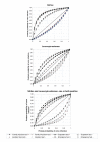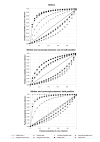The urine dipstick test useful to rule out infections. A meta-analysis of the accuracy
- PMID: 15175113
- PMCID: PMC434513
- DOI: 10.1186/1471-2490-4-4
The urine dipstick test useful to rule out infections. A meta-analysis of the accuracy
Abstract
Background: Many studies have evaluated the accuracy of dipstick tests as rapid detectors of bacteriuria and urinary tract infections (UTI). The lack of an adequate explanation for the heterogeneity of the dipstick accuracy stimulates an ongoing debate. The objective of the present meta-analysis was to summarise the available evidence on the diagnostic accuracy of the urine dipstick test, taking into account various pre-defined potential sources of heterogeneity.
Methods: Literature from 1990 through 1999 was searched in Medline and Embase, and by reference tracking. Selected publications should be concerned with the diagnosis of bacteriuria or urinary tract infections, investigate the use of dipstick tests for nitrites and/or leukocyte esterase, and present empirical data. A checklist was used to assess methodological quality.
Results: 70 publications were included. Accuracy of nitrites was high in pregnant women (Diagnostic Odds Ratio = 165) and elderly people (DOR = 108). Positive predictive values were >/=80% in elderly and in family medicine. Accuracy of leukocyte-esterase was high in studies in urology patients (DOR = 276). Sensitivities were highest in family medicine (86%). Negative predictive values were high in both tests in all patient groups and settings, except for in family medicine. The combination of both test results showed an important increase in sensitivity. Accuracy was high in studies in urology patients (DOR = 52), in children (DOR = 46), and if clinical information was present (DOR = 28). Sensitivity was highest in studies carried out in family medicine (90%). Predictive values of combinations of positive test results were low in all other situations.
Conclusions: Overall, this review demonstrates that the urine dipstick test alone seems to be useful in all populations to exclude the presence of infection if the results of both nitrites and leukocyte-esterase are negative. Sensitivities of the combination of both tests vary between 68 and 88% in different patient groups, but positive test results have to be confirmed. Although the combination of positive test results is very sensitive in family practice, the usefulness of the dipstick test alone to rule in infection remains doubtful, even with high pre-test probabilities.
Figures


References
-
- Gorelick MH, Shaw KN. Screening tests for urinary tract infection in children: A meta-analysis. Pediatrics. 1999;104:e54. - PubMed
-
- Andriole VT, Patterson TF. Epidemiology, natural history and management of urinary tract infections in pregnancy. Med Clin N Am. 1991;75:359–73. - PubMed
-
- Patterson TF, Andriole VT. Detection, significance and therapy of bacteriuria in pregnancy. Update in the managed health care era. Inf Dis Clin N Am. 1997;11:593–608. - PubMed
Publication types
MeSH terms
Substances
LinkOut - more resources
Full Text Sources
Medical

